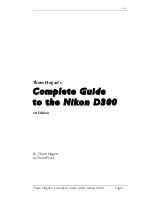
V1.02
Thom Hogan’s Complete Guide to the Nikon D300
Page 10
Since I mentioned the change in structure earlier, let me
elaborate on it so that you know what to expect in this work.
This eBook is separated into three distinct sections:
•
Things you should know and consider before using the
D300 (labeled “D300 Background” and starting on page
<25>).
In this first major section I cover a lot about how
the D300 came to be, its specifications and capabilities,
and how it differs from previous Nikon DSLRs. I’ll also
cover how to set up your camera for shooting. This
section is up front because it’s the background material
you need to get up to speed with the unique aspects of
your camera.
•
Things you need to know while using the D300 (labeled
“Shooting Pictures with Your D300” and starting on page
<224>).
This is the “how-to” section of the eBook. Here’s
where I walk you through each feature of the camera as
you’d use it. I’ll explain why you might use it, how to
make that feature active, and what your options are. Yes,
you may find a few things repeated in this section from
the first, but in the interest of making for a complete
“how-to” section, I’ve elected to repeat some set-up and
other instructions. The separate
Thom Hogan’s D300 To
Go
is a highly abbreviated version of this section.
•
Things you need to know and do after you’ve taken your
pictures (labeled “After You’ve Taken Pictures with Your
D300” and starting on page <708>).
When you come
back from shooting with your camera you still have things
you may want to do, like print, view, or improve your
images. Note that I don’t cover what you do on a
computer with your images in this section—that’s reserved
for the new
Introduction to Nikon Software
eBook that
came with this one.
The structure of this eBook also mimics the order you’ll want
to follow as you master your new camera: initiation, use, and
post production.

























